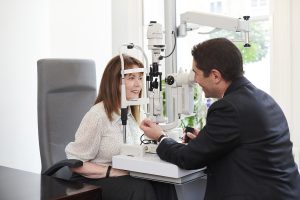Using LASEK/PRK Eye Surgery to Treat Your Refractive Error

If you have done any research at all into Laser Eye Surgery, you will probably have noticed that the profession is not averse to an abbreviation or two.
Well, that’s kind of an understatement: between LASEK/PRK, LASIK, ReLEx SMILE – the truth is, you can’t get more than two minutes into your research without coming across at least one.
While these abbreviations are obviously designed to replace complicated words that the average Joe has never heard before, they can also make us feel like we’re even further away from understanding the treatment, anyway.
Luckily for us, Laser Eye Surgery is nowhere near as complicated as all this jargon would have us believe. In fact, once you have grasped a few key differences between the main treatments, you will have a pretty clear idea of how it actually works.
What is PRK/LASEK?
One of the first abbreviations you will likely come across in your research is LASEK. This form of Laser Eye Surgery actually refers to a number of very similar procedures – including PRK, LASEK, ASA, Epi-LASIK, and Epi-LASEK – that are all known as ‘surface’ procedures.
Basically, they are all minor variations on the same surgical theme. That is to say, they are all varieties of the original form of Laser Eye Surgery – excimer laser photorefractive keratectomy, or PRK.
Since its introduction in the 1980s, PRK/LASEK has successfully transformed the vision of millions of people. Since then, it has also been developed into other forms, including advanced PRK, or Advanced Surface Ablation (ASA). In addition to common refractive errors like long-sightedness and short-sightedness, the procedure is often also used to treat corneal erosions.
So, how does it work?
In PRK/LASEK (and all surface procedures), the surgeon removes a section of the patient’s outer corneal tissue (the epithelium). This allows access to the corneal tissue below which is then reshaped with the help of a precision laser. Over the next few days, the eye grows back the epithelium that was removed during the procedure.
This is different to LASIK (which involves the creation of a corneal flap) and ReLEx SMILE, in which the cornea is accessed through a keyhole incision.
Results With PRK/LASEK Laser Eye Surgery
In the video below, Lucy, a patient, reacts to her new vision moments after her PRK / LASEK procedure.

When comparing the results of the different varieties of PRK, studies have revealed no differences at all. Evidence does suggest, however, that advanced PRK offers slightly faster recovery times and slightly less discomfort than other surface procedures.
While PRK/LASEK is still an extremely reliable procedure, more modern advancements mean that it is only used with a tiny percentage of patients at London Vision Clinic. Patients who receive PRK/LASEK treatment tend to be those who are not eligible for other treatments, such as those with unusually thin or flat corneas for whom LASIK eye surgery would be impractical.
Techniques such as LASIK and ReLEx SMILE also offer significantly speedier recovery times, meaning many people are able to get back to their normal routine in just a few days. For surface procedures, this can take a little longer.
Generally, we find that your vision will be up to driving standard within two to three weeks following LASEK Laser Eye Surgery. Nonetheless, you still may not achieve the highest standard of your new vision until between six weeks and three months after the procedure.
If you would like to learn more about PRK/LASEK, get in touch with one of our friendly clinic coordinators today. Alternatively, Book a Consultation to find out if you’re eligible for Laser Eye Surgery.


